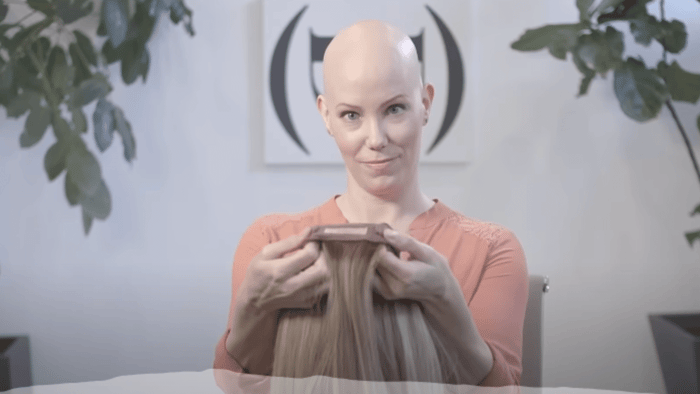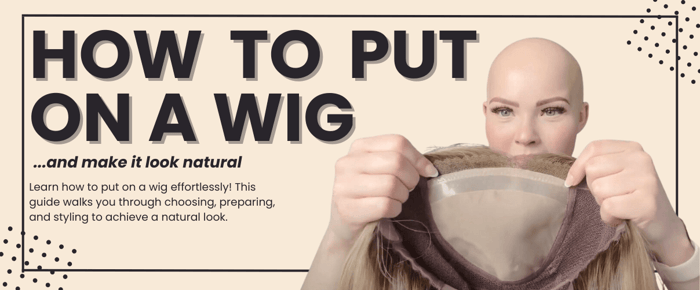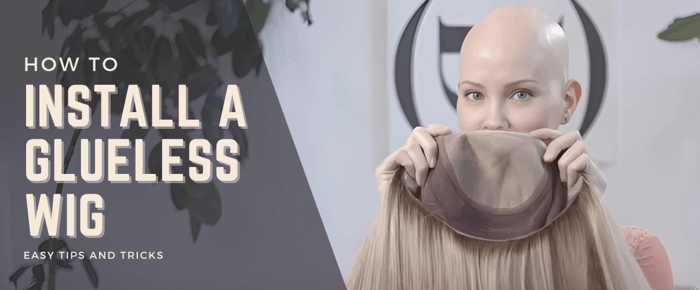If you're new to wigs, the process can seem daunting. How do you choose the right one? How to put on a wig? How do you make it look natural?
That's where this guide comes in.
This comprehensive guide will walk you through everything you need to know about wigs. From choosing the right one for your style and face shape, to how to put on a wig and making it look natural.
Whether you're a first-time wig wearer or looking to refine your skills, this guide is for you.
Table of Contents
- Understanding the Basics of Wigs and Hair Toppers
- Preparing Your Natural Hair and Scalp
- Steps For How To Put On A Wig
- Steps For How To Put On A Dimples Hera Wig
- How to Put on a Lace Front Wig for a Seamless Look
- Video Tutorial on How to Put on a Wig
- How to Secure a Wig
- Cleaning and Storing Your Wig
- Conclusion: Mastering the Art of How to Put on a Wig
- FAQs
Understanding the Basics of Wigs and Hair Toppers
Before diving into how to put on a wig, it's crucial to grasp the basics. Wigs and hair toppers come in many varieties. Each offers distinct benefits tailored to different needs and preferences.
Human hair wigs are often praised for their natural appearance and styling versatility. However, they require more maintenance. In contrast, synthetic wigs are low-maintenance and come pre-styled, making them ideal for those on the go.
Hair toppers can be a great alternative if you're experiencing partial hair loss. They blend seamlessly with your natural hair, adding volume and coverage where needed. Understanding these options helps you make informed choices.
Here are some common types of wigs:
- Full wigs: Cover the entire scalp, ideal for complete hair loss.
- Lace front wigs: Offer a natural hairline with lace material at the front.
- Monofilament wigs: Provide a scalp-like base for styling flexibility.
Knowing your preferences in terms of material and style can simplify your decision-making process. As you explore options, consider both your aesthetic goals and practical needs. By understanding the basic differences, you lay the foundation for successful wig-wearing. This knowledge empowers you to select the perfect wig and wear it with confidence.
Choosing the Right Wig for Your Style
Selecting a wig goes beyond just aesthetics. It's about finding a piece that complements your unique style and boosts your confidence. Start by considering your lifestyle and how a wig fits into it.
Color is another key factor. Selecting a hue that aligns with your skin tone can make all the difference. Warm tones suit golden undertones, while cool shades flatter pink undertones. Consulting with an expert can provide personalized recommendations based on your style preferences and needs. Remember, this choice is personal, so trust your instincts. The right wig should feel like an extension of yourself, enhancing your natural beauty and personal style.
Measuring Your Head for the Perfect Fit
Proper fit is essential for comfort and confidence. To achieve this, you'll need accurate head measurements. A well-fitting wig feels secure and looks natural throughout the day.
Here's how to measure your head for a wig:
- Circumference: Use a soft measuring tape, placing it around your hairline where the wig will sit.
- Front to nape: Measure from your forehead hairline over the top of your head to the nape of your neck.
- Ear to ear: Measure over the top of your head from one ear to the other.
Once you have these measurements, consult the wig sizing chart. This helps you determine the best size for your head. If you're between sizes, it's usually better to go slightly larger. Adjustable straps can tighten the fit if necessary. Getting the measurements right ensures a secure and comfortable fit. A perfectly fitted wig is less likely to slip or cause discomfort, enhancing your wig-wearing experience.
How to Buy a Wig for the First Time
Buying your first wig is both thrilling and nerve-wracking. Start by identifying your needs and preferences. Determine what you want in terms of length, color, and style.
Research stores or online platforms that offer a wide range of wigs. Reading reviews and seeking recommendations can help you find reputable sellers. Consider consulting with an expert for advice.
When trying on wigs, make sure to do so in different lighting to ensure the color matches your expectations. A well-chosen wig can become an integral part of your identity, helping you feel beautiful and self-assured.
Preparing Your Natural Hair and Scalp
Before wearing a wig, preparing your natural hair and scalp is crucial. This ensures comfort and extends the life of your wig. Proper preparation also helps maintain the health of your natural hair underneath.
Depending on the amount and length of your natural hair, you may need to follow different steps to prepare your hair for wearing a wig. Here are some tips for each hair type:
Short Hair
If you have short hair, you can easily prepare it for a wig by following a few simple steps.
- Start by brushing your hair back from your face to create a smooth surface.
- Secure any loose strands with bobby pins and use a light hairspray to set the style. This will help keep your natural hair in place and prevent it from peeking out from under the wig.
Medium to Long Hair
If you have medium to long hair, minimizing bulk, stray hairs and keeping your hair flat to achieve a seamless wig fit is essential.
There are a couple of options to consider.
- One method is to create pin curls by wrapping small sections of your hair around your fingers and securing them to your scalp with bobby pins. This technique helps to flatten the hair and create a smooth surface for the wig.
- Braiding hair is another option. You can make two French braids starting from the front of your head and ending at the nape of your neck. Then, cross the braids over each other and tuck them under the opposite sides of your head. Secure the braids with clips and bobby pins to keep them in place and avoid any stray hairs.
Advanced Hair Loss to Complete Hair Loss
For those with little or no bio hair (biological hair), wearing a wig cap underneath the wig can be beneficial. A wig cap is a thin, stretchy fabric that covers the scalp and provides a secure base for the wig. It helps hold the wig in place and offers comfort and protection, especially for sensitive scalps. You can choose a wig cap that matches your skin tone or the color of your wig for a more natural look.
However, with Dimples Hera wigs, you can skip the wig cap. Their PerFit® hand-tied wig caps are designed with a silky soft layer that provides an intuitive and comfortable fit, mimicking the feel of your own skin. These caps are ideal for those with sensitive skin seeking a barely-there-wear experience.
Steps For How To Put On A Wig
Putting on a wig can be a simple and enjoyable process if you follow some basic steps and tips. Whether you are wearing a wig for the first time or you are a seasoned wig wearer, you want to make sure that your wig fits well, looks natural, and feels comfortable.
Here are some steps to guide you through the process of how to put on a wig:
Step 1
Prepare your hair or scalp for the wig. If you have long or thick hair, you may want to braid it or pin it flat against your head.
This will help create a smooth and even base for the wig.
If you have short or no hair, you may want to wear a wig cap or liner to protect your scalp and prevent the wig from slipping.
Here’s a quick checklist to prepare your hair and scalp:
- Wash and condition your hair.
- Ensure complete dryness before applying a wig.
- Detangle and flatten hair against the scalp.
- Wear a wig cap for security and protection if needed.
Following these steps helps ensure a comfortable and secure experience. Proper preparation minimizes potential discomfort and enhances the appearance of the wig, allowing you to wear it confidently.
Step 2
Identify the front and back of the wig. Most wigs have a label or tag at the nape of the neck, which indicates the back of the wig.
Some wigs also have ear tabs or combs on the sides, which help with alignment and security.
Step 3
Hold the wig by the nape with both hands, making sure that the front of the wig is facing you.
Tilt your head slightly forward and place the front of the wig above your eyebrows.
Gently slide the wig over your head from front to back, being careful not to pull or tug on the lace.
Step 4
Adjust the position of the wig until it sits slightly below your natural hairline.
You can use your fingers to gently move the wig around until it feels comfortable and balanced.
Make sure that the ear tabs or combs are in front of your ears and that they are visible and not covered by the wig.
Step 5
Depending on the type and style of the wig, you may need to adjust the parting to suit your preference and face shape.
Some wigs have fixed partings that cannot be changed, while others have more flexibility and customization options.
You can use a comb or your fingers to create or change the parting as you wish.
Step 6
Check the overall appearance of the wig and make any final adjustments as needed.
You can tuck in any loose hairs or wisps that may be showing or use some styling products or tools to enhance the look of the wig.
However, be careful not to use any heat on synthetic hair wigs, as they can melt or damage the fibers.
Step 7
If the wig feels too tight or too loose, you can adjust the size using the tabs or straps at the back of the wig cap.
Most wigs have adjustable features that allow you to customize the fit to your head size and shape.
You can tighten or loosen them until you feel comfortable and secure.
Steps For How To Put On A Dimples Hera Wig
Putting on a wig can be a hassle, but not with Dimples Hera Wig.
This wig is designed for everyday wear as it makes your life easier by eliminating most of the steps involved in putting on a wig.
Dimples Wigs make wearing a wig easy and comfortable. You don't need to spend a lot of time preparing your hair or securing the wig. You can simply follow these steps on how to put on a wig and style it as you wish.
Step 1

First, look at the inside of the wig and locate the front and back labels.
The front label should be near the lace that covers the forehead, and the back label should be near the nape of the neck.
Step 2

Next, hold the wig by the front and back labels and gently place it over your head.
Make sure that the ear tabs are aligned with your ears and that the wig is not too tight or too loose.
You can adjust the size of the elastic band by using the hooks or Velcro at the back of the wig.
Step 3

Then, carefully position the front lace until it reaches your natural hairline.
The lace should blend in with your skin and create a realistic appearance of hair growth.
If you don't have a natural hairline or a reference point, you can use your fingers to measure where to place the wig.
A general rule is to leave about four fingers' width of space between your eyebrows and the edge of the wig for a realistic finish.
Step 4

Finally, you can style your wig as you normally would with your own hair.
You can use a comb, a wig brush, or your fingers to arrange the hair in any way you like.
You can also use heat tools, such as a curling iron or a flat iron, to create different looks.
However, be careful not to damage the lace or the hair fibers with too much heat or friction.
How to Put on a Lace Front Wig for a Seamless Look
Lace front wigs are popular for their realistic appearance. Installing one takes practice but is worth the effort.
- Start by prepping your skin and hairline, ensuring they're clean.
- Position the wig carefully on your head. Align the wig's lace front with your natural hairline for a flawless look. Adjust as necessary to make sure it sits securely.
- Use adhesive or tape for extra security. Apply a thin layer along the hairline, pressing the lace into place. Allow time for the adhesive to set properly.
- Once secured, blend the lace with makeup. This step helps create an undetectable transition from your skin to the lace. Choose shades that match your skin tone for the best result.
- Finally, style the wig to suit your preference. You can trim the lace gently if needed or tease the baby hairs for a natural finish. Embrace your new look confidently with your lace front wig.
Lace Front Wigs Are EXTREMELY Delicate.
One important thing to remember when wearing a Dimples Hera Wig is to avoid pulling on the lace.
The lace is very delicate and can tear easily if you tug on it or use it to adjust the wig. Instead, you should always use the ear tabs or the back label to move or reposition the wig. This way, you can protect your wig and enjoy its natural beauty for a long time.
Remember, putting on a wig takes some practice and patience, but it can also be fun and rewarding. With time, you will become more confident and skilled at achieving the perfect fit and style for your wig. Enjoy your new look with pride, knowing that your wig is well-fitted and comfortable.
Video Tutorial on How to Put on a Wig
How to Secure a Wig
Securing your wig properly ensures comfort throughout the day. A good fit prevents slippage and maintains your desired look. Confidence begins with a stable base.
Start by familiarizing yourself with the wig's adjustable features. Most wigs come with straps or combs for easy securing. Experiment to find the setup that feels most secure.
For those with sensitive scalps, wig caps can offer added comfort. They act as a gentle barrier between your head and the wig. Additionally, they help in securing the wig snugly.
If you find the wig still shifts, consider wig tape or adhesive. These products ensure a firmer hold, especially beneficial in windy conditions. Remember, a well-secured wig is one you won't need to worry about.
Finally, practice makes perfect. Each time you install your wig, you'll gain confidence and proficiency. The more comfortable you become, the more natural your appearance will be.
Here are some of the most common and effective ways to keep your wig from slipping:
1. Wig Tape
Wig tape is a double-sided tape that can be used to attach your wig to your scalp or wig cap. It is a popular choice for many wig wearers because it is easy to apply and remove, and it can provide a strong and long-lasting hold.
To use wig tape, you need to cut small pieces of tape and stick the strip of tape along the perimeter of your wig cap or directly onto your scalp.
Then, carefully align your wig with the tape and press it firmly onto the tape to create a secure bond.
Make sure to avoid any contact with your natural hair or skin, as the tape can pull or irritate them when removed.
2. Wig Glue
Wig glue is another type of adhesive product that can be used to secure your wig in place.
It is specially designed for use with wigs and can offer a more natural-looking and seamless attachment than wig tape.
Wig glue comes in different forms, such as liquid, tape, or cream, and you need to choose the one that suits your preferences and needs.
To use wig glue, you need to apply a thin layer of glue along the perimeter of your wig cap or scalp and wait for it to become tacky.
Then, carefully position your wig on top of the glue and press it gently onto the glue to create a secure bond.
Wig glue can provide a stronghold for your wig, but you need to be careful when using it.
You need to follow the instructions carefully, use the right amount of glue, and remove it properly to avoid any damage to your scalp or wig.
You also need to check the ingredients of the wig glue before using it to make sure you are not allergic to any of them.
3. Wig Grip Headband
A wig grip headband is a convenient and comfortable option for securing your wig.
It is a stretchy, breathable fabric headband that has adjustable straps that can securely hold your wig in place.
It works by creating friction between the headband and the wig cap, preventing the wig from sliding or moving.
To use a wig grip headband, you simply need to wear it underneath your wig, adjusting it to fit snugly around your head.
The headband will grip your wig without causing any discomfort or damage.
4. Silicon Sheet
A silicon sheet is a thin, adhesive sheet that can be placed on your scalp to create a non-slip surface for your wig.
The silicon material has a high friction coefficient that can grip your wig cap and prevent it from shifting or sliding.
This method can offer a secure hold without the need for tapes or glues that may leave residues or harm your scalp or hair.
To use a silicon sheet, you need to cut it into small pieces and stick them onto your scalp where you want to attach your wig.
Then, simply put on your wig and adjust it as needed.
5. Dimples Hera Wigs
If you are looking for an extra level of security and convenience for your wig, you may want to consider Dimples Hair's wigs.
These wigs feature a hand-tied cap with silicone strips that provide a secure grip for your wig without any adhesive products or damaging tapes.
The silicone strips create a suction effect that prevents the wig from slipping or shifting on your head.
You can confidently wear these wigs without worrying about them coming off.
By using these methods or choosing Dimples Hera wigs with advanced features, you can ensure that your wig stays securely attached to your head all day long.
This way, you can enjoy wearing your wig with ease and style.
Cleaning and Storing Your Wig
A clean wig is a happy wig. Regular cleaning removes oils, sweat, and environmental pollutants. Aim to wash your wig every 8-10 wears, or more frequently if needed.
Try Dimples Hair Care, a range of shampoos, conditioners and sprays that are gentle, nourishing and effective. Dimples Hair Care products are designed to keep your wig looking natural, healthy and beautiful. Whether you have a synthetic or human hair wig, Dimples Hair Care can help you maintain its quality and style.
Start by soaking the wig in cool water with a wig-friendly shampoo. Avoid scrubbing; instead, gently swirl it in the water. This method preserves the fibers and ensures longevity.
After washing, place the wig on a towel and blot gently to remove excess water. Let it air dry on a wig stand to maintain its shape. Avoid direct sunlight as it can fade color.
For storage, make sure it's dry before storing and always use a wig stand. This helps retain the wig's form and prevents tangles. If a stand isn’t available, lightly stuff the wig with tissue paper and keep it in a breathable bag or box. Proper storage is your ally in preserving that perfect look.
Conclusion: Mastering the Art of How to Put on a Wig
Putting on a wig can initially seem like a daunting task, but with practice and the right techniques, it can become a seamless part of your routine. Understanding the basics—from selecting the right wig for your style to preparing your natural hair or scalp—sets the foundation for a successful wig-wearing experience.
As you learn the step-by-step process of how to put on a wig, remember that confidence plays a crucial role. A well-fitted wig not only enhances your appearance but also boosts your self-esteem, allowing you to embrace your look with pride. Whether it’s adjusting the straps for a snug fit, utilizing adhesive for lace front wigs, or styling the wig for a natural appearance, each step contributes to achieving that perfect finish.
Practice makes perfect; the more you wear your wig, the more comfortable and natural it will feel. Don’t hesitate to seek out tips from experts or fellow wig wearers as you refine your technique. Remember, wearing a wig is not just about covering up; it’s about expressing your individuality and enhancing your unique beauty.
With the right knowledge and techniques at your disposal, you can confidently put on a wig that reflects your style and personality. Embrace the process, enjoy experimenting with different looks, and step out into the world feeling empowered and beautiful, one wig at a time.
FAQs
Are the steps for putting on a wig the same for all types of wigs?
The steps of putting on a wig are very similar for most types of wigs, but there are some slight variations depending on the type of wig cap and the style of the wig.
For example, lace front wigs require more care and attention than other types of wigs, as the lace is very delicate and needs to be trimmed and secured properly. Lace wigs are popular because they create a natural-looking hairline that allows you to wear the hair away from your face.
Lace Front Wigs
Lace front wigs have a thin strip of lace along the front edge of the wig cap that mimics the look of your natural hairline.
The lace is designed to sit flat and flush against your forehead, creating a seamless transition between the wig and your skin.
However, not all lace front wigs are the same.
Some lace front wigs come pre-cut and ready to wear, while others have excess lace that needs to be cut before wearing.
Dimples Hera Lace Front Wig stands out from other lace front wigs with its unique features that make it easier to wear and more natural-looking.
Uncut vs. Pre-Cut
Some lace front wigs have excess lace that extends beyond the hairline.
This lace needs to be carefully cut before wearing the wig, following the shape of your natural hairline.
Cutting the lace can be tricky and intimidating, as you don't want to cut too much or too little or damage the wig in the process.
If you are not confident or experienced in cutting lace, you may want to opt for a pre-cut lace front wig instead.
Pre-cut lace front wigs have the excess lace already trimmed for you, saving you time and hassle.
Dimples lace front wigs come pre-cut and ready to wear, so you don't have to worry about cutting the lace yourself.
What is the difference between a Hand Tied wig vs. Machine Made wig?
Wigs can be made using different methods of production: hand-tied or machine-made. Each method has its own advantages and disadvantages, depending on your preferences and needs.
Hand Tied Wigs
Hand-tied wigs are made by hand-knotting individual strands of hair onto a thin mesh cap.
This creates a very natural look and feels, as the hair can move freely and be parted in any direction.
Hand-tied wigs are also more breathable and comfortable than machine-made wigs, as they conform to your head shape and do not have any bulky seams or wefts.
Dimples Hera Wigs are 100% hand-tied, giving you the highest quality and most realistic wig possible.
Machine Made Wigs
Machine-made wigs are made by sewing hair onto strips of fabric called wefts, which are then attached to a cap.
This method is faster and cheaper than hand tying, but it also results in a less natural look and feel.
Machine-made wigs tend to have more volume and density than hand-tied wigs, which can make them look unnatural or heavy.
Machine-made wigs also have limited styling options, as they can only be parted in certain directions due to the way the wefts are sewn onto the cap.
Why are hand-tied wigs more expensive?
Hand-tied wigs are more expensive than machine-made wigs for several reasons:
The labor involved in making a hand-tied wig is much more intensive and time-consuming than making a machine-made wig. It can take up to six times longer to make a hand-tied wig than a machine-made wig.
The skill required to make a hand-tied wig is also higher than making a machine-made wig. Hand-tied workers need years of training and experience to master their craft. Many brands do not offer hand-tied wigs because they cannot find enough qualified workers.
The hair used for hand-tied wigs is also more costly than the hair used for machine-made wigs. Hand-tied wigs need longer hair strands to account for the return hairs, which are the hairs that are knotted through the cap and then folded back over.
What is the difference between Synthetic Hair, Human Hair & Remy Hair?
Synthetic Hair, Human Hair, and Remy Hair are different types of hair fibers that are used to make wigs. Each type of wig hair has its own advantages and disadvantages, depending on your preferences and budget.
Synthetic Hair
Synthetic hair is made from man-made fibers that mimic the look and feel of natural hair.
Synthetic hair wigs are easy to care for, as they do not require styling or washing. They also retain their shape and color well, even in humid conditions.
However, synthetic hair wigs cannot be exposed to heat, such as curling irons or blow dryers, as they can melt or damage the fibers.
Synthetic hair wigs also tend to have a shorter lifespan than human hair wigs, as they can become frizzy or dull over time.
Human Hair
Human Hair is made from real hair that is collected from donors.
Human hair wigs offer the most natural look and feel, as they can be styled, colored, and washed just like your own real hair.
They also have more movement and shine than synthetic hair wigs.
However, human hair wigs are more expensive than synthetic hair wigs, as they require more processing and care.
Human hair wigs also need to be styled regularly, as they can lose their shape or curl after washing.
Human hair wigs can also be affected by environmental factors, such as humidity or sun exposure, which can alter their color or texture.
Remy Hair
Remy Hair is a type of human hair that is considered to be the highest quality and most desirable.
Remy hair is collected from donors in a way that preserves the natural direction of the cuticles, which are the outer layer of the hair shaft.
This means that all the cuticles are aligned in the same direction, which reduces tangling and matting.
Remy hair also undergoes minimal processing, which preserves its natural strength and softness.
Remy hair wigs are more expensive than other types of human hair wigs, but they also last longer and look more natural.
Hera 23" | Remy Human Hair Lace Front Wig (Hand-Tied)

$4,700.00
Hair Type: Remy Human Hair Hair Length: 23” crown to tips, Front: 18”, Side: 18”, Back: 18”, Nape 17” Cap Size Medium: (21.5") Circumference: 21 ½ “, Front to Back: 14 ½ “, Ear to Ear: 13 ¼” Cap Size Small: (21")… read more
Hera 19" | Remy Human Hair Lace Front Wig (Hand-Tied)

$3,299.00
Hair Type: Remy Human Hair Hair Length: 19” crown to tips. Front: 13”. Side: 13”. Back: 13”-14". Nape: 13” Cap Size Medium: (21.5"). Circumference: 21 ½“. Front to Back: 14 ½“. Ear to Ear: 13 ¼” Cap Size Small: (21"), Circumference: 21",… read more
HERA 15" | Remy Human Hair Lace Front WIG (Hand-Tied)

$2,999.00
Hair Type: Remy Human Hair Hair Length: 15” crown to tips. Front: 12”. Side 9”. Back 9”,12”,13”. Nape 9” Cap Size Medium: (21.5"). Circumference: 21 ½", Front to Back: 14 ½ “, Ear to Ear 13 ¼” Cap Size Small: (21"), Circumference: 21",… read more
Hera 8" | Remy Human Hair Lace Front Wig (Hand-Tied)

$2,099.00
Greek Goddesses embody power and greatness, conquering challenges that come their way. But what Makes Hera Special? She’s the Queen of the Gods. Consider this crowning jewel worthy of her title. Hair Length: 8” crown to tips. Front: 9.5”. Side 7”. Nape… read more





